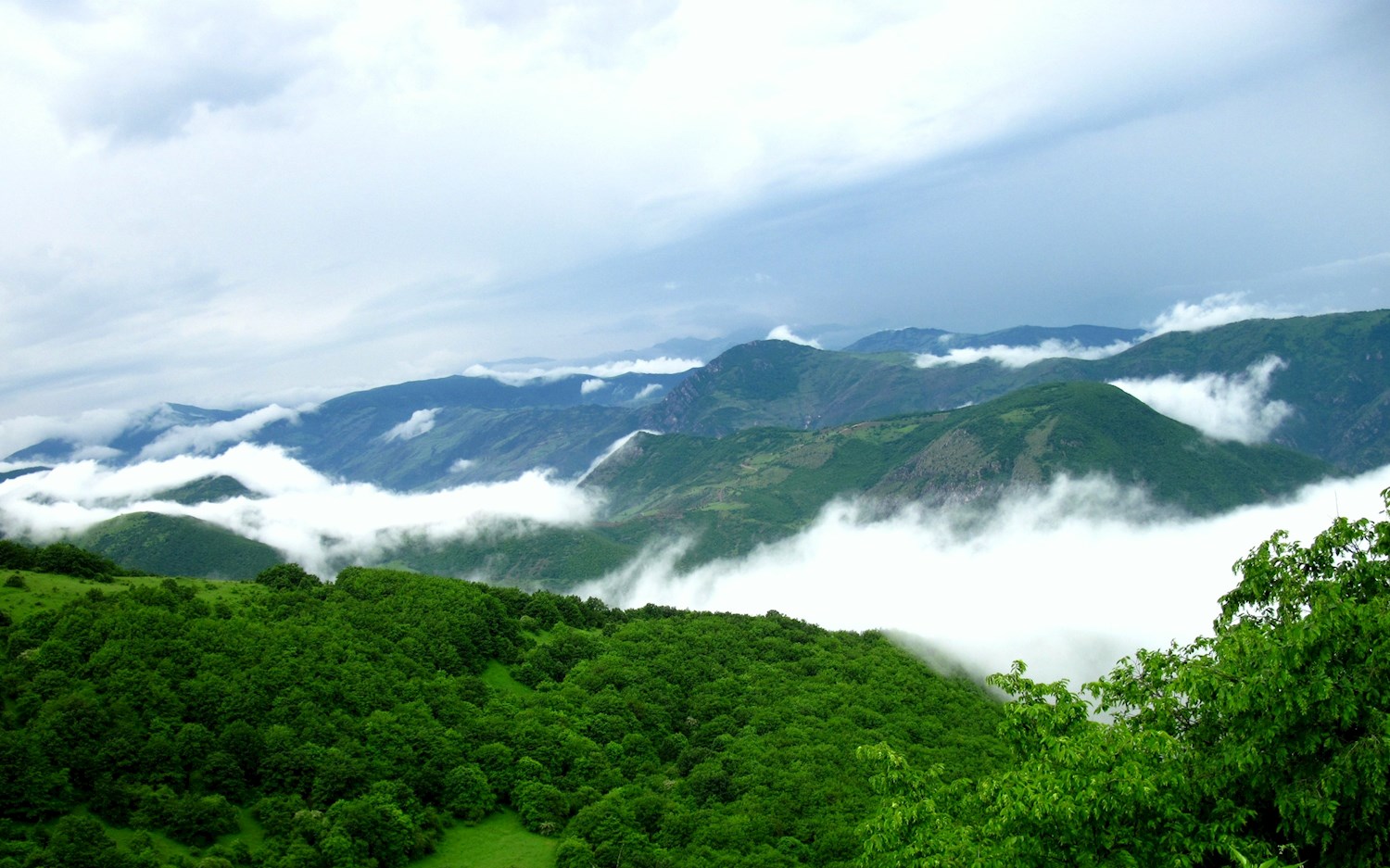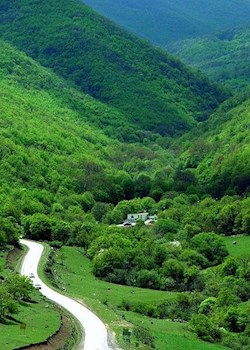Attractions
Arasbaran Protected Area
Arasbaran, also known as Qaradagh, is a large mountainous area stretching from the Qūshā Dāgh massif, south of Ahar, to the Aras River in East Azerbaijan Province of Iran.
more
Arasbaran Protected Area
Arasbaran Protected Area
Figure 1: A landscape of Arsbaran protected area
How to access: the access routes to these forests include: Tabriz-Ahar-Kaleybar road, Meshginshahr-Kaleybar road, Jolfa-Khomarlo road, Parsabad to Eskanlou road.
The forests situated in the banks of Aras river in northwestern Iran, also known as Qaradagh, with similarities to both Zagros and Hyrcanian forests and also Caucasus areas. High rocky peaks together with hornbeam, oak and blueberry forests and lowlands of Aras banks have created a special ecosystem. Forest areas of Arasbaran situated near Kaliber and rural areas of Oskelo Vinq and Aynalo and Kale Dorsi is home for bird species such as Eurasian jay, spotted cuckoo, woodchat shrike, Eurasian bullfinch, common blackbird. Also, there in more mountain areas like Anza and Nojedeh covered with shrubs and cushion plants exists precious species such as capercaillie, lachin snowcock, grey partridge and short-toad snake eagle. Most of these species live in lowlands of Arasbaran during the relatively cold winters in the area. The best time to visit this lagoon is in fall and between October and November. This area is habitat of "caucasian grouse" that is perhaps the rarest and most important animal species known in Arsbaran forests. Two endangered species in this area include phasianus colchicus and red deer whose generation are now protected with the help of population protection programs. More than 1,000 plant species are known in Arsbaran National Park that indicates the unique forest habitats in this area and the highly various plant species. Arsbaran was previously known as Qaradagh and Qarajahdagh for the abundance of the mountains in the area.
Figure 2: A beautiful view of Arsbaran protected area
Nowadays, the Arasbaran area is smaller than decades ago for the reason of deforestation and is limited to only three cities of Kaleybar, Varzaqan and Ahar. Arsbaran forests, one of the densest and most bushy forests in Iran, are the remnants of the Hyrcanian forests knows as the oldest forests of the world that dates back to the third geological era. This area is called the wildlife museum of Iran that is a name given to it for its highly diverse wildlife. The southern parts are mostly pastureland and the forest parts are situated at highlands with less than 800 meters in altitude. Besides the animal species diversity, the plant species are as well diverse in this area and includes 15% of all plant species in Iran. Altogether there exist 1,400 plants and mushrooms species in this area among which are oak and acer trees, sumac, barberry, wild pomegranate, wild apple, wild pear and raspberry and bluekberry bushes. The best time to visit is in June when the blueberries are ripe, through the summer to taste the sour cranberries. Arasbaran has mild weather and it's locally said that the temperature in Tabriz is always 10 degrees lower than that in Kaleybar and Arsbaran. This saying indicates that the weather in Arasbaran is pleasing. When travel by car, you will find the signposts on the entrance of Tabriz which guide the tourists to Ahar and Kaleybar. The green city of Kaleybar has misty slopes which are really eye-catching and beautiful.
Figure 3: Another view of Arsbaran protected area
This city, covered with forests and pastures, is also known as the fort of Babak Khorramdin. The Great Mosque of Kaleybar and Khoda-Afarin Bridges are tourist attractions of Kaleybar. The Khoda-Afarin bridges are two arch shaped bridges which connect the northern and southern banks of Aras River at the border of Iran and Azerbaijan. A new rout is recently constructed from Kaleybar city to Jananlo so that people and tourists can go towards Aras river and the borders of Azerbaijan and Armenia. If you drive 5 kilometers on this road, you will reach a historical caravanserai named Shah Abbasi caravanserai that is not such a spacious place but definitely worth visiting. The most famous and well-known tourist attractions of the area, however, include Kaleybar, Qaleh-Babak (Babak Fort), Aynaloand Makidi Darrehsi. The construction of Qaleh-Babak dates back to the Sassanid era and was named after Babak Khorramdin who led the group of fighters against the Abbasid Caliph. The historical Babak Fort is located inside the heights of Arsbaran and towards southeast, you can find this amazing valley called Darrehsi which is only three kilometers away from Kaleybar. Qaleh-Babak Camp and Babak Hotel are reached shortly after. There you can start hiking and walking and enjoy the pure nature. At 45 km from Kaleybar and in Khoda-Afrin district the protected area of Aynalo is located. This intact region is secured with a fence of barbed wire to protect the red deer and the deer. The region is covered with pasturelands and green jungles.
Figure 2: A stunning view of Arsbaran protected area
Tourists can use facilities like free shelters to enjoy their stay in the area. A historical attraction from the Qajar era is Aynalo mansion. The name Aynalo (meaning mirror-like in local language) is because of its metal roof that reflected the light like a mirror. Nowadays, only the walls of the mansion have remained intact. The next tourist attraction is Makidi Forest Park that is located on the west of the rout from Qaleh-Babak valley. Makidi was a bushy and intact forest among arasbaran forests full of hazelnut trees and was a habitat for rabbits few years back, but recently with the construction of bowers, pergolas, buffets, and parking lots the story has been changed and the forest area is not as undamaged anymore. Arsbaran National Park with an area of 8,941 HA is a part of the protected region of Arsbaran situated in the Kaleybar and Khoda-Afarin counties in Eastern Azarbaijan province. This region has been registered as a No Hunting Zone since 1968. It was known as Arsbaran protected area in 1974, and was managed since 1977 as a biosphere reserve for the conservation of plants and animals. In 2012, the area officially became a national park under the ratification 370 by the Iranian Supreme Council of Environment. The best time to visit the green forests of Arasbaran is during May and June when the weather is mild enough and tourists can enjoy the various historical and natural sites.
Labels :
Arasbaran Qaradagh Qaradağ protected area south of Ahar Azerbaijan Province Azerbaijan Province of iran Azerbaijan Saholan cave in West Azerbaijan iran visit Azerbaijan East Azerbaijan Province East Azerbaijan arasbaran protected area Arasbaran weather Arasbaran jungles Arasbaran forests Arasbaran photoes restaurant





